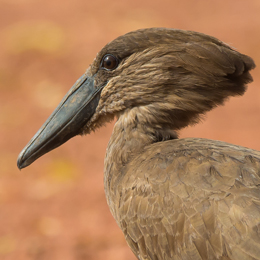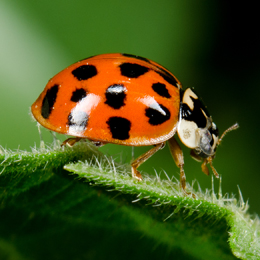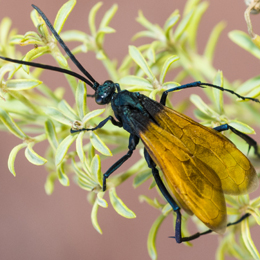Physical Description
The Radiated tortoise is known for its beauty and elegance and is the largest member of the Astrochelys genus. This species showcases an elevated, armored carapace with a blunt head that pokes out, and has elephantine feet that can hold its heavy weight. The shell, that is typically shaped like a dome, acts as a protective shield against a range of environmental threats, mostly attacks from predators in the wild.
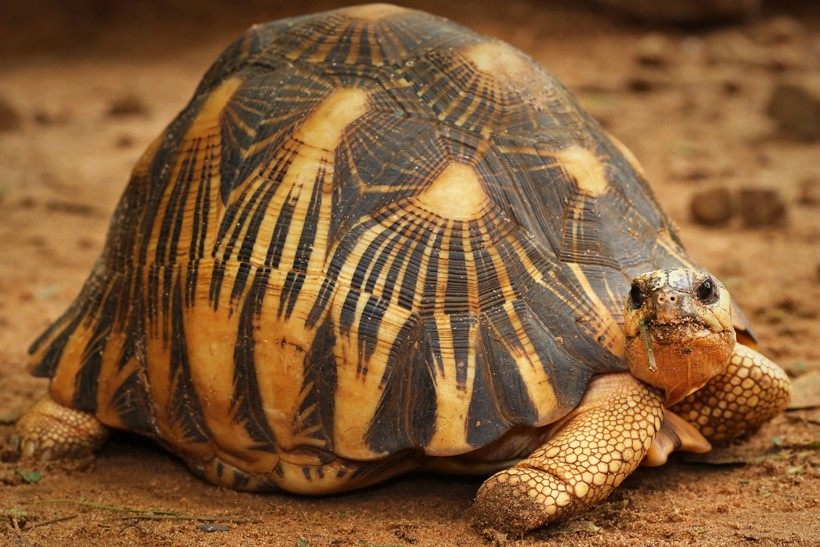
The typically dome shaped shell is an extension of the rib cage
?
Image credits: Ryan M. Bolton/Shutterstock
Sexual dimorphism is apparent in the case of the Radiated tortoise where the males typically adopt a body length of up to 40 cm while females are smaller in size, measuring about 25 – 30 cm. Males have a slightly longer tail with protruding scales that makes it easy to distinguish between the sexes. While a mature male tortoise weighs around 16 kg (35 lbs) a female can weigh up to 12 kg (26 lbs). With an average lifespan of 40 – 70 years, the Radiated tortoise prefers living a solitary life in an isolated habitat that is away from the danger of its natural predators.
Habitat
The Radiated Tortoise flourishes in Madagascar, an island that is located in the southeast coast of Africa. The species prefers an area of dry brush or woodland where it can hide behind thickets or come across dense grazing grounds. The species is known to inhabit spiny, thorny forests found in the southernmost corners of Madagascar where vegetation is generally found on poor substrates.
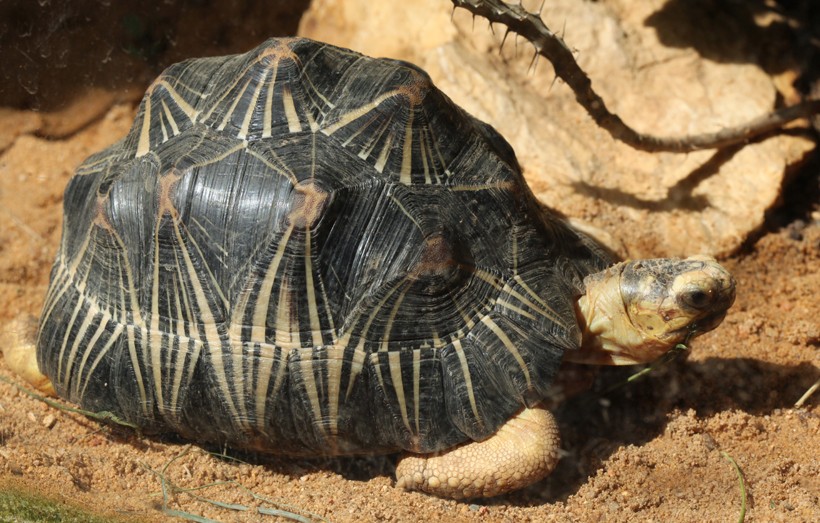
Radiated tortoise in the spiny forest of Madagascar
?
Image credits: Vladimir Wrangel/Shutterstock
These famous spiny forests of Madagascar contains a few endemic species of flora like the Didiereaceae (thorn family). The radiated tortoise can also be found in dry tropical shrubs where there is abundance in vegetation for successful grazing.
Anatomy
The Radiated Tortoise is one of the world’s most exotic species. The tortoise has been recently removed from the Geochelone genus to the Astrochelys genus, which now includes 2 species; the Radiated and Angonoka tortoise. It is easily distinguishable by an elegantly shaped exterior shell that boasts an unorthodox coloring which is a vivid combination of yellow and black lines radiating from the center of every dark plate. The impressive carapace that extends till a length of 16 cm is dome shaped with star-like patterns adorned on it. This star-like pattern is detailed and more intricate than the normal patterns you come across in few other species. The carapace is smoothly placed unlike the bumpy pyramidal shaped carapace of the Indian Star tortoise.
The shell of the tortoise is an extension of the rib cage which is divided into two parts – the carapace and the plastron. While the thick carapace lies on top, the soft tissue underneath is the plastron. The whole carapace of the tortoise is made up of small bones and layers of keratin fused to form one unified shell. The tortoise also features a stocky, muscular body with elephantine feet that contribute to its imposing appearance. Found on the extreme southern parts of Madagascar, the Radiated tortoise is a gentle creature that carries its weight on its round, nearly flat feet while walking on the sandy beaches in search of food. The species also has a tail that is thicker and longer in the case of the males where the notches beneath are clearly visible.
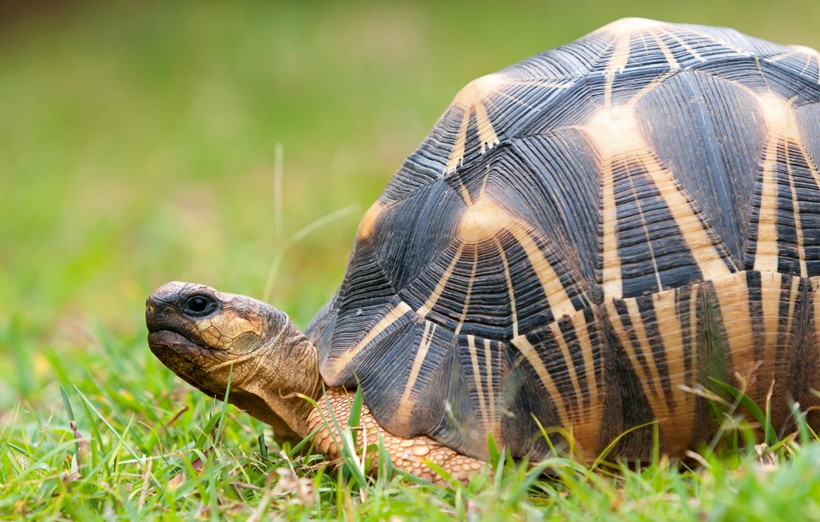
The shell which is supplied with nerves and blood vessels, is quite sensitive to touch.
?
Image credits: Pierre-Yves Babelon/Shutterstock
The Radiated tortoise is a species most sensitive to touch and reacts when the external sheath or its delicate skin is tapped. The tortoise does not have a binocular vision as its eyes are situated on both sides of its head. However, it does possess an all-round vision that can catch the slightest movement. This species does not have a well-developed auditory organ. The only primary sensory organ of this species is its sense of smell that is used for finding food, a mate or a nesting ground. A unique feature of the Radiated tortoise is that it can retract into its shell after emptying its lungs when it feels threatened or startled.
Diet
The Radiated tortoise primarily feeds on grasses and fruits found on the island. The species is a typical herbivore that regularly grazes upon certain vegetation that contains high amounts of proteins, preferring new growth as compared to matured plants. In captivity, the species is given a diet that consists of collard greens, mustard greens, carrots, romaine, escarole, sweet potato and fruits. However in the wild, this species particularly picks a grazing ground for itself where sufficient quantity of succulent plants, leaves and other kinds of vegetation is present. According to research outcome, the Radiated tortoise prefers to feed on a particular species of cactus which is the Opuntia cactus, a plant that is rich in nutrients.
Prey
Radiated tortoises are diurnal in nature which means that they foraging during daytime and rest inside their shells at night. The tortoise shell which, is supplied with nerves and blood vessels, is quite sensitive to touch. During foraging, it uses its shell and skin for plant identification by exposing its loose skin to fondle a certain plant. In general, the tortoise tends to become more active after a heavy rainfall since it signals the growth of new and blooming vegetation. This endemic species uses its sharp beak-like mouth to grasp and tear vegetation while grazing. The powerful muscles of the lower mandibles allow it to snatch out a plant or part of vegetation that is deeply rooted within the ground.
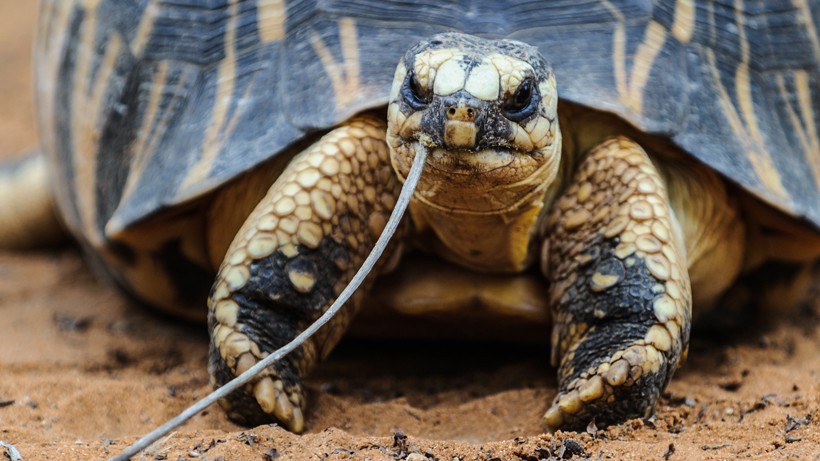
The primarily vegetarian Radiated Tortoise feeds on grasses and fruits found on the island.
?
Image credits: Anton_Ivanov/Shutterstock
The Radiated tortoise tends to return to the same grazing grounds unless there is a lack of vegetation. This species is primarily vegetarian. However, it is able to consume small animals or insects if vegetarian food source is scarce. In general, its diet contains leafy greens, herbs, grasses and fruits like berries, prickly pears. The tortoise has a long, slender neck that it can stretch out to consume a plant that is located at a certain height. In circumstances of food limitation or shortage, this species has the ability to survive under these severe conditions. In a situation of drink water shortage, the tortoise is able to extract and assimilate the moisture content from almost completely dried food items by using the hindgut system. On the other hand, it uses its double digestive tract for re-absorption of complete dried consumed food.
Predator
The Radiated tortoise is a docile creature that doesn’t react unless it feels threatened. If a predator approaches the tortoise tends to create a screeching sound as a defense mechanism. Its primary mode of defense is the hard carapace and the ability to pull its head and soft limbs within its shell that is almost impenetrable. However despite such abilities, there are a few predators that can easily break through this defense. Large birds like Golden Eagles, Ravens and other feed on the Radiated Tortoise. Other predators can consist of badgers, kit foxes, and coyotes. However, humans have become the greatest threat of this species.
Reproductive Cycle
The Radiated tortoise starts its mating rituals once it reaches half its adult size, approximately gained after 15-20 years. The mating season usually takes place during the wet season when plenty of food is available and circumstances are relatively easy to build a nest. Although this species is a solitary grazer, during the mating season it starts searching for a suitable mate. A male tortoise follows a female congener, nudges her and begins a noisy ritual of bobbing its head up and down against her carapace. The males generally produce a ‘grunt’ like sound while mating and may attempt to lift the female tortoise with the front edge of its shell.
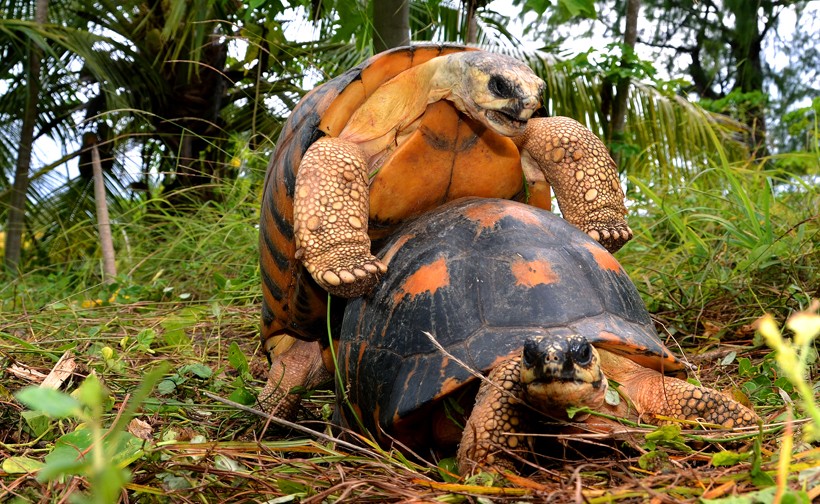
The mating usually takes place during the wet season
?
Image credits: ANDRZEJ GRZEGORCZYK/Shutterstock
Once copulation is completed, the females are ready to lay their eggs. However before doing so, they start digging a nest using their back legs. A flask-shaped hole, which is about 6-8 inches deep, is prepared for nesting where the female deposits 3 to 12 spherical shaped eggs. The female covers the eggs with mud and other ground foliage to prevent intrusion, especially from predators. The tortoise eggs undergo an incubation period of 145 to 231 days. Parental care is absent in case of the Radiated tortoise since the female abandons the nest after laying her eggs.
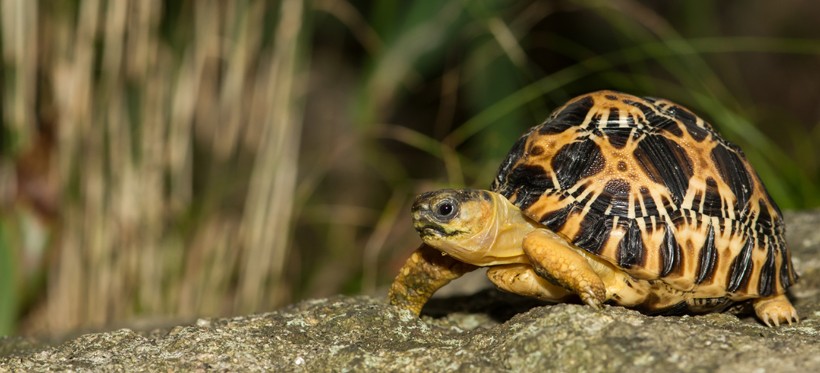
Newborn Radiated Tortoises measure about 3.2 to 4 cm
?
Image credits: Jay Ondreicka/Shutterstock
Juveniles that are born measure about 3.2 to 4 cm upon hatching and portray an off white coloration. However, they do possess a brightly colored carapace just like their parents that consists of the beautiful star like patterns. The carapace is flattened at birth but reaches a dome-shaped structure soon with rising age. The hatchlings also showcase a bilateral symmetry and soon adopt the ways of surviving in the wild. Many juvenile Radiated tortoises fall prey to a number of predators or are captured by poachers in the wild for illegal pet trade. Large snakes, birds, rats and pigs often feast on tortoise eggs before they can hatch if a particular nest is left exposed.
Behavior
The Radiated tortoise is an early riser that is mostly active during the day. The day starts with foraging in the open wilderness or searching for dead/decaying matter during the fall. This tortoise is primarily classified in the category of herbivores. However, in times of scarcity, it may also consume small animals. Lumbering around with their heads lowered, they closely crop the grass and other vegetation with their powerful jaws, leaving behind neatly trimmed patches. The species is a peaceful animal that only becomes aggressive if it experiences a threat. In the wild, the Radiated tortoise has been observed to stand on its stocky hind legs while pulling out plants or leaves from a tree. It uses its large, flat feet for digging burrows for the creation of a nesting spot.
The species drinks gallons of water to avoid long periods of dehydration. In fact, according to a particular study, the Radiated tortoise shows aggregation behavior during the wet season at discrete sites. The study suggests that the species has an underlying knowledge of certain sites where water is plenty. During such a period the tortoise drinks a lot of water which it stores within its body. This adaptation allows it to withstand the hottest temperatures of the year and go without water for long periods. The Radiated Tortoise is a solitary traveler but during the wet season, it comes together for mating and uptake of large amounts of water.
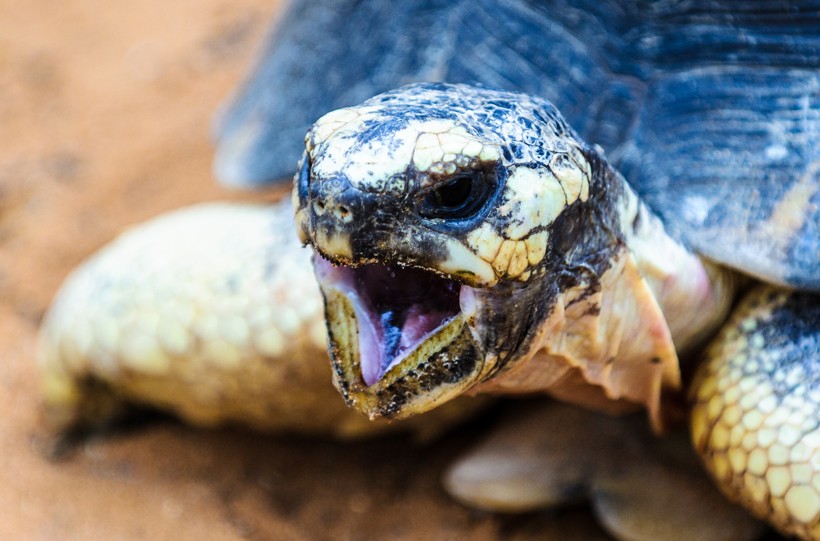
Radiated Tortoises makes a loud or high pitched shriek to startle predators
?
Image credits: Anton_Ivanov/Shutterstock
As the daytime temperature rises, the Radiated tortoise prefers subsiding into burrows underground or rests under shady bushes to escape the heat. As a matter of communication, the Radiated tortoise tends to grunt during courtship. However, it lets out a loud or high pitched shriek to startle a predator. There have been reports that the species has been found also in the coastal sandy dunes and high inland plateaus of Madagascar. The species is quite indifferent in the presence of humans. However, they can be found rarely far away from its resting burrows since humans have become a massive threat.
Threats
The Radiated tortoise is one of the most exotic species of the tortoise family. The species faces a number of threats in the wild but the most vicious predators are the humans. The Radiated tortoise is frequently hunted by poachers to be sold illegally in pet trade markets. According to the IUCN, the species has been listed already as Critically Threatened since 40% of its population already disappeared from Madagascar. The remaining population is continuously exploited for end number of reasons.
Already since 1975 the Radiated tortoise has been listed in Appendix I of CITES as a consequence of the frequent hunting by armed bands of poachers. According to the Turtle Survival Alliance and Wildlife Conservation Society over-exploitation has led to a situation that within a time span of 45 years this species will become extinct when the hunting continues by poachers and Asian smugglers.
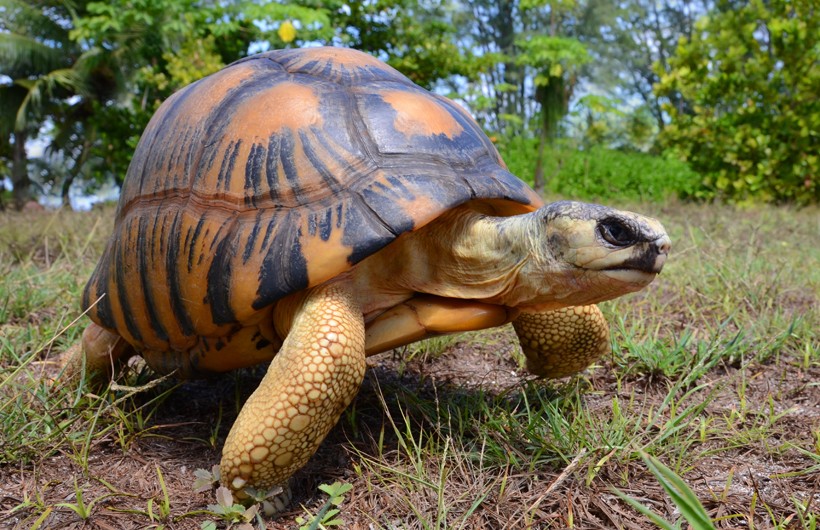
Radiated Tortoises are Critically Threatened
?
Image credits: ANDRZEJ GRZEGORCZYK/Shutterstock
Another severe threat is habitat destruction that has exposed the species to a number of predators and human-based activities. An increasing number of road kills, destruction of burrows and deforestation are major threats. Quite recently a large patch of thorny forests in Madagascar was cleared away for charcoal production.
In one research project, the number of Radiated tortoises were counted in an area round Kokobara with a radius of 5.19 km. Where 55 individuals were expected, only 35 individuals could be actually counted.
The use of the tortoise shell for making ornaments and jewelry has become a common practice. Apart from this, the species is also harvested for its meat and has now become part of an illegal international trade circuit. Every year 45,000 tortoises are harvested for this illegal trade and meat processing. The Malagasy tribe is known for being active in this illegal circuit.
Conservation
Because of the terrifying decline, many captive breeding programs like the SSP (species survival plan) in North America have adopted certain conservation methods to protect this species from becoming extinct. Around 1405 specimens have been conserved under the SSP captive breeding program to ensure a healthy colony. The captive breeding program in New York Zoological Society’s Wildlife Survival Center contributes to the conservation of the gene pool of the species by providing adequate hatchling care, monitoring adult diet and managing male-female interaction.
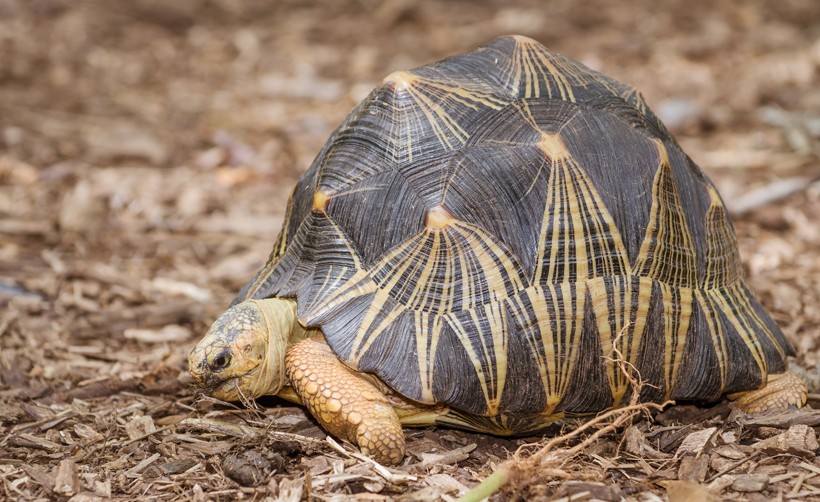
With many captive breeding programs an attempt is made to protect this species from becoming extinct.
?
Image credits: Rob Hainer/Shutterstock
The Radiated Tortoise project under the Madagascar Biodiversity Partnership was initiated back in 2000 to conserve flagship species from extinction by reaching out to the community and holding conservation educational classes. Conservation Fusion, another project in Madagascar that started in July 2011 is working on global education programs where more than 700 students engaged in an interactive study of the Radiated Tortoise and the need to conserve it.
Funfacts
- An alternative name for the Radiated Tortoise is Sokake, a name that is commonly used by the natives in Madagascar.
- The oldest specimen of the Radiated Tortoise recorded till date was Tu’I Malila that died at an age of 188 years.
- The Radiated tortoise has been introduced to nearby Madagascar islands like Mauritius and Reunion as part of a conservation project.
- In March 2013, illegal traders were arrested for smuggling 21 Radiated tortoises and 54 Angonoka tortoises through the Suvarnabhumi International Airport in Thailand.
- The age of the Radiated tortoise can be estimated from the number of growth rings that are present on its scutes or bony plates that form the shell.
- During a heavy shower, the Radiated tortoise makes certain dancing movements which look as though it is trying to remove debris from its back.

